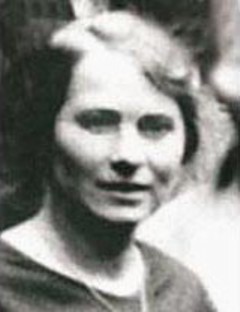
Sabina Nikolaevna SPIELREIN (1885, Rostov-on-Don — 1942, Rostov-on-Don) — Russian psychoanalyst. In 1904 at the age of 18 she was admitted to a psychiatric clinic in Zurich, where she met the young doctor Carl-Gustav Jung, with whom she entered into psychoanalysis. After a year their love affair began which lasted for 7 years. In June 1905 she entered the Department of Medicine at Zurich University from which she graduated in February 1911 with the thesis on schizophrenia: Uber den psychologischen Inhalt eines Falles von Schizophrenie (Dementia praecox), which Jung used in his own book Wandlungen und Symbole der Libido (1912). She explained the psychotic's fear of sex by relating it to the patient's fear of disintegration. They are really afraid to lose themselves, i.e. to dissolve into other person, whom they love. That is why schizophrenics replace the real world with their own fantasies. She continued the theme of the losing of the self in her later works.
Spielrein left Zurich in January 1911, and continued corresponding with Jung until 1919. First, she settled in Vienna, where she visited Freud's Psychoanalytischen Vereinigung. There she married Pavel Scheftel in 1912 and bore a daughter Renata in 1913. Ten years later they returned to the USSR, first to Moscow, then to Rostov-on-Don, where she founded a psychiatric hospital for children and held a teaching position at the university. From 1924 psychoanalysis was outlawed in Russia, but she continued an illegal analytic practice. During 1935 — 1937 her three brothers vanished in the purges. Her husband died in 1938 and in 1941 Rostov-on-Don was occupied by the German army. She did not believe in the Nazis' cruelty and she refused to escape her native town. With many other Jews she and her two daughters were herded into the synagogue and murdered by the Nazis in August 1942. No one knows the precise date of her death.
She is remembered in the history of psychoanalysis as the author of world-famous work Die Destruktion als Ursache des Werdens (her Ph.D. thesis of 1912), which was basic for Freud's theory of the death drive. That is why Coline Covington and Barbara Wharton consider Sabina Spielrein to be the 'Forgotten Pioneer of Psychoanalysis'. In her thesis Spielrein put for the first time one of the most difficult and important questions in analytic theory and practice, the question about the death drive, which arose through her research on masochism. There is an initial we-experience that is opposite to I-experience, and that is related to destruction of the 'I'. At the same time, the destruction of the self and regression into we-experience has positive results, because it intensifies social development and cultural progress. She concludes that destruction is the basis of further development. In any dissociation, we can find a cause of becoming.
Classical psychoanalysis understands the correlation between sexuality and death drives in a very different way. In Beyond the Pleasure Principle Freud states: 'In her rich and sapid work, which unfortunately is not completely clear for me, Sabina Spielrein anticipated a considerable part of my own meditations. She noted a sadistic component of sexual drive as a "destructive drive".' (Freud S. Jenseits des Lustprinzips. Wien, 1920). Freud supposed the sexual drive and death drive to be the two forces deriving from one and the same pleasure principle, therefore, unlike Spielrein, he does not hold them to be contradictory. Both love and destruction entail pleasure, unlike the repetition that is beyond the pleasure principle.
Although her thesis was useful and prolific both for Freud (with whom she has a correspondence) and for his disciples, unfortunately, like her teacher and analyst Jung, Sabina Spielrein did not exert essential influence on contemporary psychoanalysis.
-=-
Spielrein S. Die Destruktion als Ursache des Werdens. Jahrbuch fur Psychoanalyse. No. 4, 1912; English version: Destruction as Cause of Becoming. (2004);
Spielrein S. Diario di una segreta simmetria (1980);
Spielrein S. Journals de 1907 et 1908. in Bloc-Notes de la Psychoanalyse No. 3, 1983;
On Sabina Spielrein:
Alnaes K. Verdadera Historia de Sabina Spielrein. (2005);
Carotenuto A. A Secret Symmetry: Sabina Spielrein between Jung and Freud. (1982; 1983); Hayman R. A Life of Jung. (2001);
Kerr J. A Most Dangerous Method: The Story of Jung, Freud, and Sabina Spielrein (1993);
Martynkewicz W. Sabina Spielrein and Carl Gustav Jung: Eine Fallgeschichte (2003)
Sabina Spielrein: Forgotten Pioneer of Psychoanalysis. Ed. by Coline Covington and Barbara Wharton. (2003);
-=-
© Dmitry A. Olshansky, M.A. in Philosophy (St. Petersburg)
E-mail: olshansky@hotmail.com
